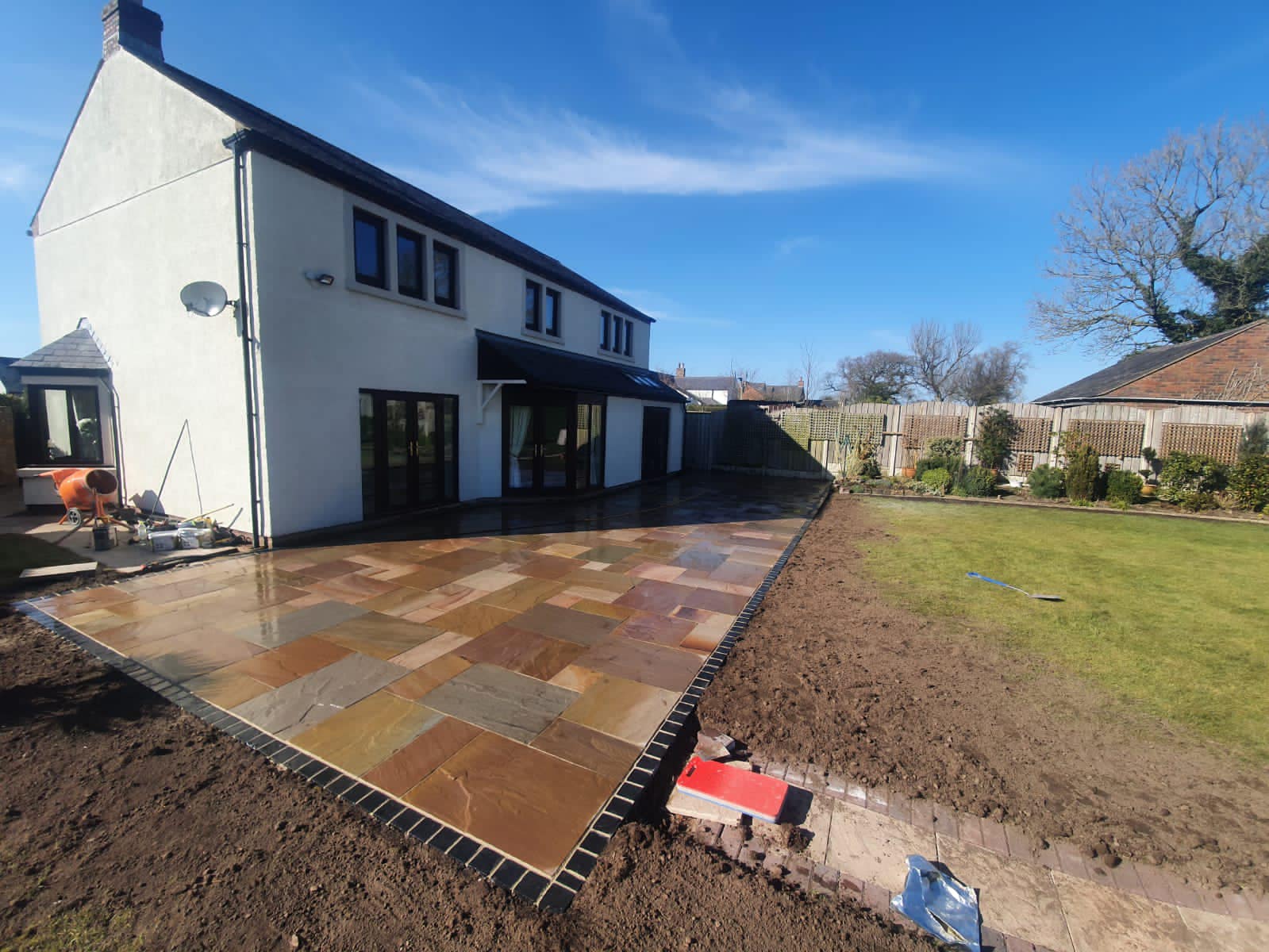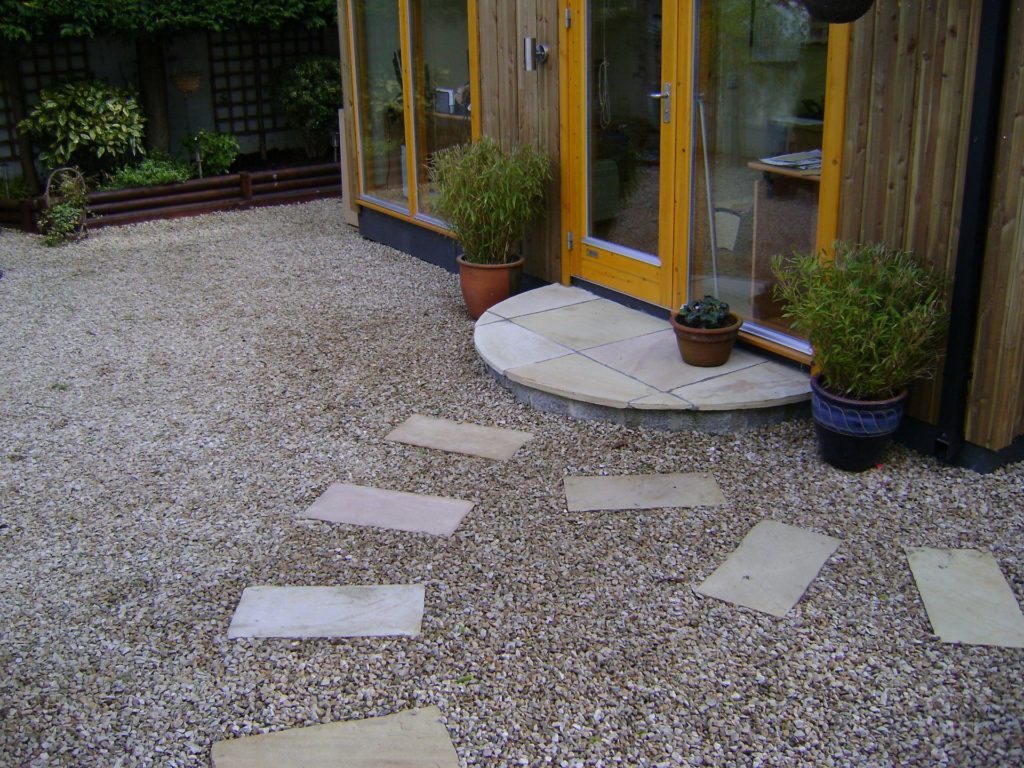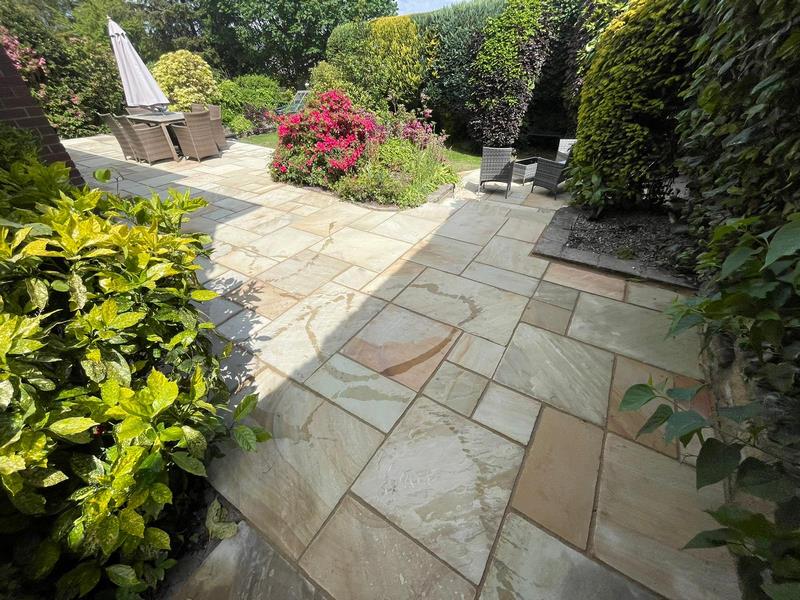Indian Sandstone Steps: Patio Perfection
Indian Sandstone Steps: Patio Perfection
Transforming your outdoor space into a haven of relaxation and beauty often involves careful consideration of every detail. While patios provide the foundation for outdoor living, Indian sandstone steps can elevate the design, adding both practicality and aesthetic appeal. This comprehensive guide delves into the world of Indian sandstone steps, exploring their benefits, design considerations, installation process, maintenance, and overall contribution to patio perfection.
The Allure of Indian Sandstone
Indian sandstone, quarried from the rich geological formations of India, is a highly sought-after material for paving and landscaping. Its unique characteristics make it an ideal choice for creating stunning and durable patio steps. These characteristics include:
-
Natural Beauty: Each slab possesses a unique texture and color variation, lending an organic and visually captivating quality to any design. The natural veining and subtle color shifts create a sense of depth and character, unlike the uniformity of manufactured materials. From warm, honey-toned hues to deep, earthy browns and reds, there’s a shade of Indian sandstone to complement virtually any architectural style and surrounding landscape.
-
Durability and Longevity: Known for its exceptional strength and resistance to weathering, Indian sandstone can withstand the rigors of outdoor exposure for many years. It's relatively resistant to frost damage, making it a suitable choice for climates with freezing temperatures. Properly installed and maintained, a sandstone step system can easily last for decades, adding lasting value to your property.
-
Versatility: Indian sandstone is available in a wide range of finishes, sizes, and thicknesses. This versatility allows for creative freedom in step design, accommodating various architectural styles and personal preferences. You can opt for riven (naturally cleft) surfaces for a rustic look, flamed finishes for a textured feel, or honed surfaces for a sleek, polished appearance. The size and shape of the slabs can be customized to fit the specific dimensions of your patio and surrounding landscape.

- Slip Resistance: When properly installed and sealed, Indian sandstone offers excellent slip resistance, enhancing safety, especially in wet conditions. This is crucial for outdoor steps, where the risk of slipping is significantly higher.
Design Considerations for Indian Sandstone Steps
The design of your Indian sandstone steps plays a crucial role in both their functionality and aesthetic integration with your patio. Several factors should be considered before embarking on the installation:

-
Step Height and Rise: The height and depth (rise and run) of each step are critical for ergonomics and safety. Consistent step dimensions ensure comfortable ascent and descent, preventing accidents. Building codes often stipulate guidelines for step dimensions; adhere to these regulations to ensure compliance.
-
Step Width: Adequate step width provides ample space for comfortable foot placement. Consider the anticipated foot traffic and the overall width of your patio when determining the ideal step width.
-
Step Material Selection: The choice of Indian sandstone type – its color, finish, and texture – should harmonize with the overall aesthetic of your patio and surrounding environment. Consider the existing paving materials, the architectural style of your home, and the surrounding landscaping to ensure a cohesive and visually pleasing outcome.

-
Layout and Design: The layout of the steps should be carefully planned to ensure a smooth and natural flow from the patio to other areas of your garden. Straight steps are the simplest option, but curved or winding steps can add a touch of elegance and visual interest. Consider the available space and the overall landscape design when choosing a layout.
-
Integration with Surroundings: The steps should integrate seamlessly with the existing patio and landscaping. Matching or complementary colors and textures can create a unified and visually appealing space. Consider incorporating planting, lighting, and other landscaping elements to enhance the aesthetic impact of the steps.
Installation of Indian Sandstone Steps

Installing Indian sandstone steps is a process that requires careful planning and execution. While DIY is possible for simpler projects, it's often advisable to engage professional paving contractors for complex installations or for ensuring the longevity and safety of your steps. Here's an outline of the general process:
-
Site Preparation: This crucial step involves excavating the area to create a level base for the steps. Proper drainage is essential to prevent water accumulation and potential damage to the steps. A solid, compacted base is crucial for stability.
-
Foundation: A stable foundation is essential for the longevity of your steps. This typically involves laying a layer of hardcore or concrete to provide a firm base for the sandstone slabs.

-
Laying the Steps: Each sandstone slab should be laid carefully, ensuring level placement and proper alignment. Mortar or paving adhesive is typically used to secure the slabs to the foundation. Ensure proper spacing between slabs to accommodate expansion and contraction due to temperature fluctuations.
-
Pointing (Grouting): Once the slabs are in place, the gaps between them are filled with mortar or pointing material. This creates a solid and aesthetically pleasing finish, preventing weed growth and improving the overall stability of the steps.
-
Sealing: Applying a suitable sealant protects the sandstone from staining, water damage, and weathering. Choose a sealant specifically designed for exterior use and follow the manufacturer's instructions carefully.

Maintenance of Indian Sandstone Steps
Regular maintenance is key to preserving the beauty and longevity of your Indian sandstone steps. Here are some essential maintenance tips:
- Regular Cleaning: Regularly sweep or brush away dirt, leaves, and debris to prevent staining and maintain the appearance of your steps. Use a soft brush or broom to avoid scratching the sandstone surface.

-
Weed Removal: Regularly remove weeds that may grow between the slabs. A weed killer specifically designed for patios and pathways can be used, but be cautious to avoid damaging the sandstone.
-
Stain Removal: Address stains promptly to prevent them from becoming permanent. Use a mild detergent and water solution for cleaning most stains. For stubborn stains, consult a professional stone cleaning service.
-
Resealing: Reseal your sandstone steps every 2-3 years, or as recommended by the sealant manufacturer, to maintain protection against weathering and staining.

The Perfect Finishing Touches
Once your Indian sandstone steps are installed and maintained, consider these finishing touches to elevate the overall design:
- Lighting: Strategic lighting can enhance the beauty of your steps and create a welcoming ambiance in the evening. Consider pathway lighting or uplighting to highlight the texture and color of the sandstone.

-
Landscaping: Incorporate plants, shrubs, or flowers around your steps to create a visually appealing and integrated landscape design. Choose plants that complement the color and texture of the sandstone.
-
Handrails: For safety, particularly on steeper steps, consider installing handrails for added support and stability.
Conclusion: A Timeless Investment

Investing in Indian sandstone steps is an investment in the beauty and longevity of your outdoor space. Their natural beauty, durability, and versatility make them an excellent choice for creating stunning and functional patio features. By carefully considering design elements, ensuring proper installation, and undertaking regular maintenance, you can enjoy the elegance and practicality of your Indian sandstone steps for years to come, transforming your patio into a true haven of outdoor living. The unique character and timeless appeal of this natural stone will undoubtedly enhance your property's value and provide a source of lasting enjoyment.
Indian Sandstone Steps: Patio Perfection
Creating the perfect patio involves careful consideration of many elements: the overall design, the materials used, and the functionality of the space. While patios often feature expansive flat surfaces, it's the inclusion of thoughtful details, like steps, that elevate a good patio into a truly exceptional outdoor living area. And when it comes to step materials, few options offer the blend of beauty, durability, and versatility as Indian sandstone.
This comprehensive guide will delve into the world of Indian sandstone patio steps, exploring their aesthetic appeal, practical advantages, and the process of designing and installing them to achieve patio perfection. We'll cover everything from choosing the right type of sandstone to maintenance tips, ensuring your investment remains stunning for years to come.
The Allure of Indian Sandstone
Indian sandstone, quarried from various regions across India, boasts a rich history and a unique visual character. Its natural variations in colour and texture make each piece one-of-a-kind, offering a level of individuality unavailable with manufactured materials. The most common colours range from warm, earthy tones of beige, buff, and honey to richer hues of red, brown, and even grey. This diverse palette allows for seamless integration with a wide range of architectural styles and landscaping designs.
Beyond its aesthetic appeal, Indian sandstone possesses remarkable durability. It's a naturally strong and dense stone, resistant to weathering, frost damage, and general wear and tear. This resilience ensures your steps will withstand the rigours of daily use and the elements, maintaining their beauty for decades. Furthermore, it's relatively easy to maintain, requiring minimal effort to keep them looking their best.

Several types of Indian sandstone are suitable for patio steps, each offering a distinct look and feel:
-
Rajasthan Yellow: A popular choice for its warm, golden hue and relatively smooth texture. It's a versatile option that complements a wide array of design styles.
-
Kota Blue: Known for its distinctive blue-grey tones and slightly textured surface. It offers a cooler, more contemporary look than warmer sandstone options.

-
Mint: This softer, lighter-coloured sandstone exudes a tranquil and elegant ambiance. It works particularly well in settings with lush greenery.
-
Autumn Brown: This rich, earthy tone is perfect for creating a warm and inviting feel. The variations in its colour and texture add a rustic charm.
The choice of sandstone will largely depend on your personal preferences, the overall style of your patio, and the surrounding landscape. It’s advisable to view samples in natural light to assess their colour and texture accurately.

Designing Your Indian Sandstone Steps
Designing effective and aesthetically pleasing patio steps requires careful planning and consideration of several factors:
- Step Height and Depth: The standard rise (height) of a step is between 6 and 8 inches, while the tread (depth) should be around 10 to 12 inches. These dimensions ensure comfortable and safe ascent and descent. However, these measurements can be adjusted depending on the overall design and the space available.

-
Number of Steps: Determine the number of steps required based on the height difference between the patio levels. Avoid excessively long flights of stairs, breaking them up with landings if necessary.
-
Layout and Shape: The layout of the steps can be straight, curved, or L-shaped, depending on the space and overall design. Curved steps can add a touch of elegance and soften the lines of a patio.
-
Materials and Finishes: Aside from the type of sandstone, consider the finish. Indian sandstone can be honed (smooth), flamed (textured), or tumbled (worn), each providing a different aesthetic. A honed finish is sleek and modern, while a flamed finish is more rugged and rustic. A tumbled finish gives a more aged and weathered look.

-
Integration with Surrounding Landscape: The steps should seamlessly integrate with the surrounding patio and landscape. Consider the materials used for the patio itself, the surrounding plants, and the overall style of your outdoor space. Matching or complementing colours and textures are essential.
-
Lighting: Incorporating lighting into your step design enhances both safety and aesthetics. Low-voltage landscape lighting can highlight the beauty of the sandstone and provide adequate illumination at night.
Installation of Indian Sandstone Steps

While you might consider DIY, the installation of Indian sandstone steps is best left to experienced professionals. Improper installation can lead to structural instability, safety hazards, and damage to the stone itself. A professional installer will ensure:
-
Proper Foundation: A solid and level foundation is crucial for the longevity and stability of the steps. This often involves excavating the ground, laying a compacted gravel base, and pouring a concrete foundation.
-
Accurate Laying: Each stone needs to be carefully laid, ensuring even spacing and a secure fit. Mortar or paving adhesive is used to secure the stones in place.

-
Drainage: Proper drainage is essential to prevent water accumulation and potential frost damage. The installation should include measures to allow for water to drain away from the steps.
-
Finishing Touches: Once the steps are laid, they may require grouting to fill any gaps between the stones. The final step often involves sealing the sandstone to protect it from staining and weathering.
Maintaining Your Indian Sandstone Steps

Indian sandstone is relatively low-maintenance, but regular cleaning and occasional sealing will help preserve its beauty and longevity.
-
Regular Cleaning: Sweep or brush the steps regularly to remove dirt, leaves, and debris. For more thorough cleaning, use a mild detergent and a soft brush, rinsing thoroughly with water. Avoid using harsh chemicals or abrasive cleaners that could damage the stone's surface.
-
Sealing: Sealing your Indian sandstone steps every few years will help protect them from staining and weathering. A sealant will create a protective barrier, preventing water and other substances from penetrating the stone. Choose a sealant specifically designed for natural stone.

-
Weed Control: Prevent weeds from growing between the stones by regularly applying a weed killer or using landscaping fabric.
-
Winter Care: In colder climates, take precautions to prevent ice buildup on the steps. Use ice melt products specifically formulated for natural stone to avoid damage.
Conclusion: Elevating Your Patio with Indian Sandstone Steps

Indian sandstone patio steps are a superb investment, offering a perfect blend of aesthetic beauty, durability, and practicality. Their natural variations in colour and texture add character and charm, while their inherent strength ensures they withstand the test of time. By carefully considering the design, choosing the right type of sandstone, and engaging professional installers, you can create a stunning focal point for your patio, elevating it from a simple outdoor space to a truly exceptional area for relaxation and entertainment. With proper maintenance, your Indian sandstone steps will be a source of pride and enjoyment for many years to come, adding lasting value to your home. So, embrace the natural elegance and enduring beauty of Indian sandstone, and transform your patio into a space of lasting perfection.

